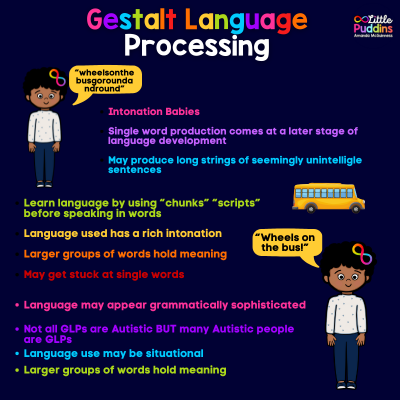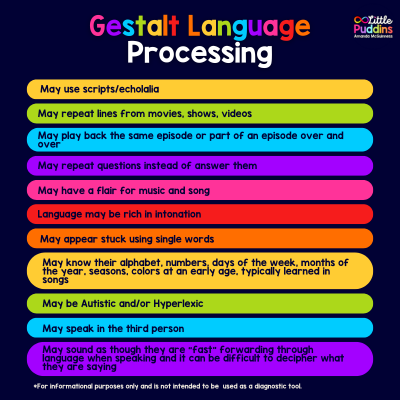Gestalt Language Processing Terms
Gestalt Language Processing Terms
(This post was originally written in 2023)
For many parents I know gestalt language processing terms can seem confusing and overwhelming. I am currently in my final year in my Masters in Childhood Speech and Language Need and have a keen interest in Gestalt Language Processing.
I will be creating a series of posts on Gestalt Language Processing over the coming months so check back regularly for updates.
Gestalt Language Processing Terms To Know
I have created a FREE PDF version of this blog post for you to download for personal use. I have as much as possible explained complex terms in as easily digestible language as possible.
I know first hand as a parent to three incredible Autistic children what it is like to be inundated with new terms to learn.
Natural Language Acquisition
Natural Language Acquisition (NLA) is a developmental process through which children understand and express language. It describes the natural development of language for gestalt language processors. Marge Blanc in her book “Natural Language Acquisition on the Autism Spectrum” coined the NLA term.
NLA encourages the individuals natural language development processes and strategically supports the development of their language towards self-generated utterances.
NLA is based on the pioneering decades long clinical research of Barry Prizant and Ann Peters together with their colleagues in their work with Autistic and non-Autistic children.
Gestalt Language Processing / Gestalt Language Acquisition
The term “gestalt language processing” also referred to as “gestalt language acquisition” is a process of language development wherein an individual develops (produces and understands) language in word(s), phrase(s), or complete sentence(s) that they’ve heard from caregivers, family/friends, from media (ex. Youtube / Cartoons) and in their social environment.
Gestalt language processing is a natural way to develop language. Gestalt language processors follow predictable stages in their language development. These stages eventually lead to original, flexible language.
This form of language development is particularly prevalent in the Autistic population.
Gestalts
Gestalts mean organised “wholes” and in the context of GLP it can mean a gestalt language processor is using whole words/phrases/sentences – chunks of language. For example my son Max (5) is a GLP and he will often script chunks of language he has heard from a show on kids YouTube that he likes (media gestalts). This chunk of language is called a “gestalt”. These gestalts as a whole are incredibly meaningful as a “whole” for Max and it is for me to identify what this “whole” chunk of information means.
Stages of Natural Language Acquisition Process
Marge Blanc’s Natural Language Acquisition (NLA) provides that there are 6 developmental stages. The process begins (Stage 1) with the gestalts individuals ascertain from their language sources (ex. parents, siblings, community, media). In Stage 2 these gestalts are broken down, and are broken down further in Stage 3. Singular words begin recombining in Stage 3. Later in stages 4-6 grammar rules take centre stage.
Echolalia
We all engage in echolalia. In the context of GLP it is an essential element of the GLP language development.
There are 2 types of echolalia (Immediate & Delayed Echolalia) to be aware of and GLPs may utilise both.
Immediate Echolalia
Either immediately or after a very brief delay language observed is repeated.
Delayed echolalia
After a significant delay, language that is observed is repeated. In Stage 1 of NLA, the GLPs primarily use delayed echolalia/gestalts.
Media Echolalia
language observed in media and then repeated. Media can include audio-visual media.
Gestalt Mitigation
After Stage 1 of the NLA GLP individuals will begin to “mitigate” gestalts and this will ultimately lead to flexible use of language. Marge Blanc refers to it is a “mixing and matching” process in her book “Natural Language Acquisition on the Autism Spectrum”.
Over time the GLP individual will gain a large repertoire of gestalts that are used by them in a meaningful manner. They will be able to identify commonalities in many of their gestalts and will with support be able to deconstruct the static gestalts to then re-combine one gestalt with another in a meaningful manner.
Easily Mitigatable Gestalt
An easily mitigatable gestalt is usually a gestalt in stage 1 or 2 of the NLA that can be deconstructed and re-combined with other gestalts/mitigations. These utterances/phrases can be easily mixed/matched and moved around with other phrases and still sound natural. Gestalts originated from everyday sources such as home life/community life will be more easily mitigated than for example an utterance from a cartoon on You Tube.
Gestalt Thinking/Gestalt Cognitive Processing (GCP)
If an individual has been identified as a GLP it is probable that they may also bea gestalt cognitive processer (GCP).
Gestalt Thinkers may process events as a “whole”, their memory may be episodic. They may identify and remember specific elements of a memory. GCPs may have a hyper-focused memory wherein they have a hyper-awareness of specific details of an event. These specific details may make up what the consider to be the “whole” of the event. When observing language and developing gestalts they may tune into chunks of the language (gestalts) and utilise these gestalts later in the exact within which they first identified them.
I hope you have found this post helpful. You can download your FREE PDF copy of this post here.





